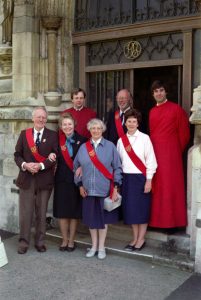 My second Lady Apollonia West Country Mystery, Plague of a Green Man, is set in Exeter, Devon, in the year 1380. Exeter’s fourteenth century cathedral was largely completed before that year and plays an important role in my story because its Cathedral Church of St. Peter is dear to my heart. In the four different years that I lived in Exeter with my husband, I served as a steward and tour guide at the cathedral. In the picture on the left, I am shown with four other stewards and two vergers. My experiences in Exeter served to inspire the Lady Apollonia mystery novels, so when one of these was set in Exeter, the appearance of the cathedral was inevitable.
My second Lady Apollonia West Country Mystery, Plague of a Green Man, is set in Exeter, Devon, in the year 1380. Exeter’s fourteenth century cathedral was largely completed before that year and plays an important role in my story because its Cathedral Church of St. Peter is dear to my heart. In the four different years that I lived in Exeter with my husband, I served as a steward and tour guide at the cathedral. In the picture on the left, I am shown with four other stewards and two vergers. My experiences in Exeter served to inspire the Lady Apollonia mystery novels, so when one of these was set in Exeter, the appearance of the cathedral was inevitable.
In an earlier posting, I discussed the carvings of green men throughout Exeter Cathedral and the use of the term, “green men”, in my book title. The story refers to the cathedral in many other ways. Several of my fictional characters work in the cathedral precincts. Eric Aunk is the cathedral pitmaker while Baldwin Chumleigh is a fictional canon of the secular cathedral. However, the 1380 real-life Bishop of Exeter, Thomas Brantyngham, and Dean of Exeter, Thomas Walkyngton, are also referred to in my story.
The plot of the mystery includes a trial that takes place in the chapter house of the cathedral. Two villains in the story seek sanctuary in the great church. Some of the crime in the story occurs within the Cathedral Close when two men leave the church after attending a worship service there. Even the ancient underground passages of Exeter which extend to the cathedral precincts play a role in the story.
Some highlights of visiting the cathedral are described in the book when Lady Apollonia is given a tour. The Lady is made aware of the then partially completed image screen on the West Front before she enters the cathedral through the north porch. Many points of interest in the interior were the same in 1380 as they are today: the tierceron vaulting, the Becket boss, the Minstrel’s Gallery, the green man boss in the south quire aisle, and the figures in the corbels at the four corners of the crossing.
The Tumbler’s Corbel is discussed in the book when Apollonia’s youngest son, David, comes home from the cathedral school one afternoon and tells his mother all about the carving of a tumbler doing his acrobatic tricks over a fiddler. This corbel is opposite another across the nave of the church which portrays Mary, the mother of Jesus, holding her baby. The tumbler and fiddler are performing in their most skilful way as a gift for the Virgin and Child.
For more information on Exeter Cathedral, click on https://en.wikipedia.org/wiki/Exeter_Cathedral
Tags: Chaucer's England, historical fiction, medieval mysteries